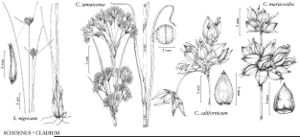Cladium mariscoides
Ann. Lyceum Nat. Hist. New York 3: 372. 1836.
Rhizomes to 10 cm × 2 mm. Culms 0.3–1 m × 1–2 mm. Leaves: blades conduplicate to sub-involute, (1–)2–3.5 mm wide, smooth or nearly so. Inflorescences terminal or lateral and terminal, pedunculate, peduncle mostly covered by subtending leaf sheath, 15–25 cm; 1st and 2d order branches (rarely congested and with little obvious branching), branches stiffly ascending. Spikelets in groups of 3–5(–30), narrowly ellipsoid to lanceoloid; floral scales 5–6, the proximal chestnut brown, ovate to oblong-lanceolate, 2.5–3 × 2 mm, midvein conspicuous, lateral veins weak; stamens 2; anthers 2 mm, connective apices 0.1 mm; styles 2–2.5 mm; stigmas 1–1.5 mm. Achenes whitish or pale green, ovoid, 2.5–3 × 1.5–1.7 mm, base 3–6-lobed, discoid, truncate and impressed, flared, apex subacute, irregularly rugulose longitudinally, glossy.
Phenology: Fruiting summer–early fall.
Habitat: Open acidic to alkaline wetlands, brackish upper edges of tidal marshes
Elevation: 0–400(–1200) m
Distribution

Man., N.B., Nfld. and Labr., N.S., Ont., Que., Sask., Conn., Del., Fla., Ill., Ind., Maine, Md., Mass., Mich., Minn., N.H., N.J., N.Y., N.C., Ohio, Pa., R.I., S.C., Tenn., Tex., Vt., Wis.
Discussion
Selected References
None.
